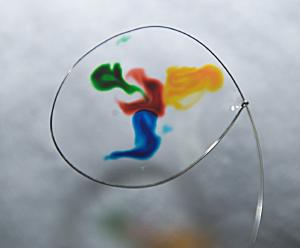Blog
Shake, Rattle and Roll
5 May 2015
 Philip Pearle and Brian Collett
Philip Pearle and Brian CollettIf you’ve ever watched dust-motes dancing in a sunbeam then you’ve observed Brownian motion. It is the jerky, fluttering motion of particles in fluids such as air or water. While the effect was known as least since the ancient Greeks, it is named after the botanist Robert Brown, who in 1827 first described the motion in detail. He demonstrated that it was not caused by some living organism, but was never able to determine its cause. While there were suspicions that the motion was caused by the collision of atoms against the particles, it wasn’t confirmed until Einstein’s 1905 paper “Investigations on the theory of Brownian Movement.”1
Although it’s now common knowledge that things are made up of atoms, the idea was long seen as controversial. In the early 1800s John Dalton proposed that matter consists of indestructible spherical particles known as atoms, and that these atoms came in various types called elements. Dalton was mainly trying to address the fact that chemical reactions between different types of materials (elements) seemed to occur in particular ratios. The atomic model explained this process well, but required atoms to be so extraordinarily tiny that we had no hope of observing them. By the late 1800s Ludwig Boltzmann had expanded the idea into a kinetic theory of gases, in which he proposed that the properties of a gas, such as its temperature and pressure, were due to the the motion and interactions of atoms and molecules. This provided a theoretical way to connect heat (thermodynamics) with the Newtonian ideas of work and energy.
 Wikipedia
WikipediaThroughout the 1800s, scientists were divided between “atomists” such as Dalton and Boltzmann, and their opponents such as Ernst Mach. At the heart of the debate was the fact that atoms couldn’t be measured. You could speculate about their existence all you wanted, but the atomic hypothesis was untestable. Which brings us to Einstein’s paper on brownian motion. Einstein wasn’t the first to propose atomic collisions as a solution to brownian motion, but what made his paper so powerful was that it connected physical properties of atoms to something we could actually measure. His paper focuses on a property of fluids known as diffusion. If you put drops of food coloring in water, it will spread out over time. This is due to the fact that the coloring is bouncing around with the water molecules. Since the molecule collisions are random, the coloring will move with a pattern known as a random walk. You can think of it as taking a step, then turning in a random direction and taking another. On average the position of the coloring will stay the same, but by chance some will drift outward. Thus, over time the coloring diffuses.
What Einstein showed was that the diffusion of an object undergoing Brownian motion will diffuse at a particular rate (known as the mean squared displacement), and that this rate depended upon the number of atoms or molecules in a mole of the fluid in which the object is suspended (Avogadro’s number). From this one could determine the size of molecules or atoms. For the first time, a measurable quantity allowed us to probe the atomic realm. It wasn’t just the idea, but rather the precision of Einstein’s results that many scientists found so convincing.
Einstein’s work settled a dispute that had raged for nearly a century, and it placed kinetic theory on an experimental foundation. From this work, Newtonian physics, chemistry, and thermodynamics were connected.
Tomorrow: Not content with bringing together three separate areas of science, Einstein takes on the the bizarre realm of the quantum with the photoelectric effect.
Einstein, Albert. “Über die von der molekularkinetischen Theorie der Wärme geforderte Bewegung von in ruhenden Flüssigkeiten suspendierten Teilchen.” Annalen der physik 4 (1905). ↩︎